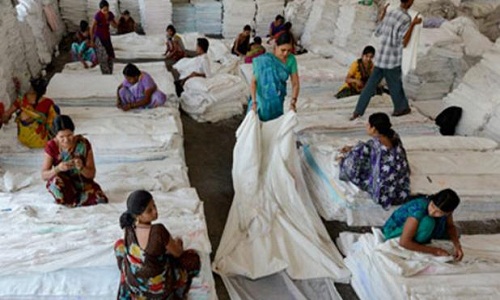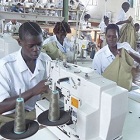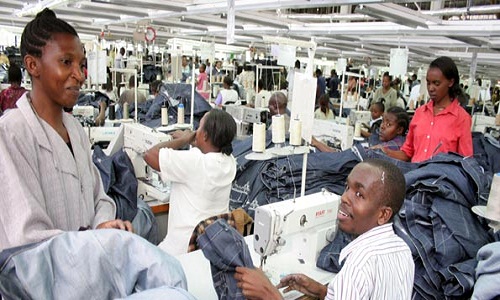FW
"The adverse impact of demonetisation on disposable incomes and hence consumer spending has resulted in a slowdown in domestic demand for apparels and other end-products of textile industry in the immediate term. The resulting inventory accumulation with the retailers will, in turn, cause deferment of purchases from apparel/home-textile manufacturers (focussed on domestic market) in the near term, besides resulting in stretched payments. This, in turn, will affect the cash flow of the textile industry and is likely to drive a constraint in the demand for the entire textile value-chain, remarks leading research agency ICRA."

The adverse impact of demonetisation on disposable incomes and hence consumer spending has resulted in a slowdown in domestic demand for apparels and other end-products of textile industry in the immediate term. The resulting inventory accumulation with the retailers will, in turn, cause deferment of purchases from apparel/home-textile manufacturers (focussed on domestic market) in the near term, besides resulting in stretched payments. This, in turn, will affect the cash flow of the textile industry and is likely to drive a constraint in the demand for the entire textile value-chain, remarks leading research agency ICRA.

While textile retailers are facing the immediate impact, the impact on apparel manufacturers and other intermediaries in the value chain is expected to be felt with a lag of a few weeks, with reduction in orders due to a slower off take of the channel inventory. The overall impact on the sector, however, is expected to be limited as 1/3rd of the Indian textile industry is estimated to be export focussed (directly or indirectly). Also, as the demand reverts to a steady state over the next few months with expected improvement in liquidity, this impact will be neutralised.
Winter-wear segment to be worst-affected
In ICRA’s assessment, the impact of demonetisation is likely to be the most severe for winter-wear retailers and manufacturers focussed on the domestic market, who witness 60-70 per cent of their annual sales during the period October-February. Though from the manufacturers’ end, the shipments typically take place by September-October, pressure on sales in the retail space during the subsequent peak season can indirectly affect manufacturers. While on the one hand, slow sales increase the possibility of stock returns to manufacturers or affect order book for the next year in the light of unsold inventory; on the other hand, slow sales and consequent liquidity pressures on retailers can result in stretched payments to the manufacturers.
Cash crunch delays cotton arrivals
The harvest season for cotton in India begins in October, with major cotton arrivals happening till March. New cotton arrivals are typically accompanied by softening of cotton prices from the levels during the period April-September. While a similar trend was observed this year, announcement of demonetisation on November 8 has delayed cotton arrivals in the market due to widespread prevalence of cash payments to farmers. Accordingly, farmers are holding on to inventories resulting in a fall in daily cotton arrivals in November 2016 vis-à-vis corresponding previous, thereby resulting in artificial supply shortage and bottoming of cotton prices.
Short-term phenomenon, largely affecting the unorganised segment; yarn manufacturers to remain insulated In ICRA’s view, the slowdown in cotton arrivals and resultant marginal up-tick in cotton price post November 8, 2016 is a short-term phenomenon, which has already started to correct, as farmers have gradually started accepting alternate modes of payments. Further, the yarn manufacturers are expected to be insulated from this mismatch, given the sizeable inventory maintained by them on an ongoing basis.
The impact is expected to be pronounced on the unorganised segment, which forms a large part of the domestic textile sector where cash transactions are more prevalent, as reduction in currency circulation is likely to temporarily affect their routine business transactions.
Overall in ICRA’s view, the impact of the demonetisation is expected to be felt across the textile value chain in the near-term. While on the one hand, the impact is likely to trickle down from a slowdown in spending on apparels and other end products on the demand side; on the other hand, the reduction of currency in circulation is likely to adversely affect the unorganised segment and cotton procurement in the ongoing season of inventory build-up. Nevertheless, this is only expected to be a short-term phenomenon.
In the cost-sensitive spinning business where most products are generic, the last thing that any company would ask for is to create a brand. RSWM, the flagship company of $1 billion LNJ Bhilwara Group did precisely that. Giving a deaf ear to experts advising caution the company launched yarn brands with the conviction that the consumer needed change. The result was that the company launched its first yarn brand in 2011, one of the first instances of branding within the country’s yarn sector.
Following the commissioning of its state-of-the-art SJ-11 unit, the company launched the Ultima brand of grey yarn. The sales of Ultima increased to 11 per cent in 2015-16. Then, encouraged by the success, the company launched Edge, its niche value-added brand of superior yarn products in 2015. The brand immediately addressed an unmet customer need. Revenues from Edge accounted for 12 per cent of the company’s sales volume in 2015-16.
The grey yarn that was earlier priced as a commodity, now fetches a reasonable premium over competing variants, moves faster off shelves and has enhanced the company’s corporate brand. Revenues from branded products increased from 8 per cent in 2014-15 to 13 per cent in 2015-16.
The next step was to customize and manufacture yarn as per customer specifications and requirement. The company’s ‘3/7/25’ counter-response was fundamentally simple, three days for lab prototyping, seven days for trial sampling and 25 days for bulk manufacturing.
The company created product development centres within its manufacturing locations. It invested Rs 134 crores in enhancing its capabilities and allocated dedicated infrastructure and resources for timely product development and monitored the progress of each customer request on a real-time basis. The result is that even as the broad yarn market continued to be challenging.
Nandan Denim which began with a six million-meter annual capacity in 2004 now crafts 110 million meters of fashion fabrics. The company is in the process of initiating internal projects that are woven around bringing efficiencies in quality, delivery and waste control.
Nandan has added yarn dyed/solid fabrics. In the last five years the company is managing a strong CAGR of 20 per cent in sales and 36 per cent in net profit. Nandan Denim plans to create a portfolio of hybrid brands straddling across consumer segments and price points.
Nandan Denim aims to achieve cost optimization and benchmarking efficiency at its manufacturing units. Another priority is fabric innovation. It is also well-positioned to capitalise on the soaring export demand. The fully integrated manufacturing facility caters to the needs of customers by providing a variety of products under a single roof. The hope is that the on-going expansion in denim fabric capacity and backward integration will better operating margins and return ratios.
In future Nandan is looking to increase its share of value-added products and adding more processing facilities coupled with innovative and fashion first products. This will enable it to manufacture a wide range of denim fabrics, fetching higher average realisations and profitability.
Hanesbrands has made a huge splash in its relatively short tenure as a publicly traded company. The US major is best known for undergarments, but other products include sports apparel and hosiery. In its most recent quarter, it saw a 11 per cent rise in revenue, with adjusted earnings from continuing operations climbing by 12 per cent.
Hanesbrands enjoyed strong share-price performance between 2012 and 2014, prompting the company to split its share last year. Hanesbrands did extremely well coming out of the gate, seeing its share price climb by more than 50 per cent less than a year after its IPO. But the recession of 2008 and the ensuing financial crisis sent the stock falling sharply, reaching single-digit share-price levels before bottoming out and rebounding.
It didn't take long for Hanesbrands to get back to where it had traded before the crisis, but several years of sluggish performance put a cap on the stock’s appreciation potential. That changed in late 2012. From there, the stock doubled in less than a year and substantial gains continued through 2014 and into early 2015. By the time the company decided to do a stock split, its share price had climbed almost to $130.
The number of chemicals used in the making of fashion-forward jeans is extensive and controversial too. After major players in the denim industry sounded off their concerns for Aniline, a chemical used in indigo dyeing, during the recent Kingpins Transformers, the substance has garnered new attention from quite a few.
Despite growing campaign against chemical and its possible links to cancer, the said chemical is used by major brands in the denim industry. Till now, Scandinavians are the only ones who have completely Aniline-free. It is the main raw material used in the manufacturing indigo. It was first obtained and isolated from indigo in 1826, taking its name from the actual plant where the substance was found Indigofera anil.
The Environmental Protection Agency’s (EPA) reports that Aniline has been under the organizations statutes/regulations since 1978 making the possible dangers of the substance known for over the last 30 years. The Agency spoke on the possible consequences of Aniline exposure beyond the classification of a possible carcinogen, explaining that the chemical vapors can also be absorbed through the skin. This enforces anxiety among denim heads due to the skin contact associated with wearing a garment that crossed paths with the chemical. However, the EPA also said that they are unaware of any recent issues with Aniline and denim assuaging those concerned about the possible ban from the industry.
Donald Trump’s announcement that he intends to pull the United States out of the Trans-Pacific Partnership (TPP) agreement has breathed new life into the largely dormant Regional Comprehensive Economic Partnership (RCEP). It is a rival multilateral free trade proposal that puts China and ASEAN in leading roles.
Signed in February this year, the TPP was expected to liberalise trade among its 12 signatory Pacific Rim nations including the US, Canada, Mexico, Vietnam, Malaysia and Japan. Cambodia’s exclusion from the trade pact was seen as potential blow to the Kingdom’s economy, primarily because the deal would give some of its competitors particularly Vietnam a privileged access to the US market.
Jayant Menon, Lead Economist for Asian Development Bank’s office for Regional Economic Integration, said that the uncertain future of the TPP had galvanised interest in the RCEP, a more inclusive and less-stringent 16-nation Asia-Pacific free trade agreement that includes all 10 ASEAN member states as well as China, India and Australia. With the TPP effectively dead, Menon feels this would provide an opportunity for the RCEP to fill the vacuum and set the scene for trade policy in this region. While it would be tempting to think of the RCEP as a China-centric deal, Menon said that despite China being the dominant economy in the grouping, the trade deal should benefit all signatories if implemented properly.
However, unlike the TPP, the rival multilateral trade proposal does not require its member countries to liberalise trade or enact sweeping economic reforms. RCEP has to become more ambitious in terms of what it needs to achieve, and [its signatories must] avoid concluding an agreement seen as achieving too little in terms of genuine reforms. Analysts say the TPP’s lofty reform goals, and that potential legal entanglements would largely be handled by US Courts, were defining reasons why certain Asian countries including China and Cambodia were unlikely to seek inclusion in the deal.
Retailers have long depended on sale of high-margin winter coats and boots to boost their annual profits but with the season becoming shorter and warmer, US fund managers, convinced that the industry is becoming a victim of climate change, are leaving departmental stores and apparel stocks. The industry's long supply lines are one reason why apparel companies and department stores struggle to adjust to warmer winters. The industry is also still wedded to the idea that buyers want winter coats which tend to have margins of around 40 percent in early October when summer weather often stays on.
On record, the 2015-2016 winter was the warmest that prompted many US fund managers to abandon apparel stocks altogether. Approximately 48 per cent of US actively managed equity funds have zero exposure to apparel companies up from the 38 per cent of funds that rejected apparel stocks at this time last year, according to a data by Morningstar.
There are signs that this season will continue to be hard on apparel makers. The average temperature in October was nearly 58 degrees. That was the third-warmest October on record and the warmest since 1963, according to the National Centers for Environmental Information.
The average October temperature has warmed by 0.6 degree per decade over the last 30 years, with only September having a greater increase in average warmth, it is learnt. Fifteen of the 16 warmest years on record have been in the 21st Century.
The depreciation of Indian currency is a boost for export of garments but for a short term. It is being said that this depreciation will be good for the export industry only if the situation continues for a longer period.
The rupee plunged to a record low of 66.246 against the US dollar on November 8 before recovering to settle at 68.395 on December 1. One of the reasons for the decline in value is outflow of money from prospective foreign investors. As Ajay Sahai, Director General and CEO of Federation of Indian Export Organisations comments the fall in Indian rupee is good news for exports industry and with the rupee depreciation and rise in dollar value, improvement in export of garments is expected at least for short run. But the country will be at loss if there is greater fall in values of currencies from other major emerging markets.
Raja Shanmugham, President, Tirupur Exporters’ Association feels the depreciation of the Rupee has definitely helped garment-oriented exports. However, the gain is only for a short-term as we have been experiencing this kind of situation since the last few years when the rupee falls by the year end and the value begins to increase within a few days. Hence, most
"While opportunities are rife, Ghanaian companies and artisans are not able to explore US markets as expected. Owing to this, US Ambassador to Ghana, Robert P Jackson, has made repeated attempts to leverage the Africa Growth and Opportunity Act (AGOA) to expand their businesses and contribute more to the growth of the Ghanaian economy. For him, the potential under the Act was enormous, he urged local business to ensure that they took advantage of it to their benefit."

While opportunities are rife, Ghanaian companies and artisans are not able to explore US markets as expected. Owing to this, US Ambassador to Ghana, Robert P Jackson, has made repeated attempts to leverage the Africa Growth and Opportunity Act (AGOA) to expand their businesses and contribute more to the growth of the Ghanaian economy. For him, the potential under the Act was enormous, he urged local business to ensure that they took advantage of it to their benefit.

The entire discussion was a part of the Annual General Meeting of the American Chamber of Commerce (AMCHAM) Ghana, in Accra held recently. He also gave the assurance that there was not likely to be any changes to the Act under the administration of billionaire businessman, Donald Trump. The world is presently sitting on tenterhooks awaiting to see what new policies Trump will introduce and what he will review or scrap. During his political campaign for votes, the US President-elect made a number of comments regarding foreign policy and trade treaties, issues which many are not clear his next line of action should be assume the reins of government come next year.
Reaping the benefits of AGOA advantage
Ghana has enjoyed access to the US market under the AGOA since its inception in 2000. AGOA presents a significant opportunity for Ghana to increase its manufacturing capacity and diversify its exports. Majority of the country’s exports to the US are raw materials, with cocoa and wood being top exported products. A lack of supply capacity, lack of financial resources and AGOA’s ad hoc implementation has led to its underutilisation.
AGOA is the US government’s signature trade initiative with sub-Saharan Africa, with 37 beneficiary countries enjoying duty-free status for exports into the US. AGOA waives duties on more than 6,400 products exports from eligible African countries to the US. AGOA has recently been renewed for the next 10 years by the US Congress.
As of June 2015, AGOA-eligible countries had exported nearly $480billion worth of goods to the US. By providing duty-free access to the US market, AGOA has succeeded in helping eligible nations grow, diversify their exports to the US, and create employment and inclusive economic growth although there is still much left to be desired. Under AGOA, eligible countries can export products including value-added manufactured items such as textiles to the US duty-free.
Ghana’s export of apparel and clothing under the AGOA has expanded from less than $250,000 in 2001 to more than $9million last year. Melinda Tabler-Stone - Charge d’ Affaires at the US Embassy at a workshop in May this year highlighted that with investment partnerships with US companies and technical assistance from USAID, we fully expect to see another large increase in exports in 2016 with the potential to provide employment opportunities for thousands of people.
Dhaval Color Chem, based in Mumbai, provides digital textile printing, sublimation digital printing and screen textile printing solutions. The company has opened a facility in Bangladesh, where the garment industry can experience the printing technology and collect samples. Dhaval will also provide the technology, training and everything required for textile printing.
The facility is meant to address the lacunae in the country’s readymade garment industry, especially in value addition for printing, and to add more value to the product range. Bangladesh mainly exports only plain garments but this is seen as insufficient to maintain steady garment exports.
Bangladesh has a target of reaching $50 billion in garment exports by 2021. Another reason for Dhaval to start operations in Bangladesh is the geographical location and cultural similarities between Bangladesh and India.
With recent advances in digital textile printing, many complicated patterns and colors can now be instantly printed on textiles, giving images and original art-work a new canvas. With cutting edge digital print technology, Dhaval offers new generation, high speed technology with unique print solutions that meet all printing requirements. The company answers all digital printing needs through direct to garment printing and direct to fabric printing.












